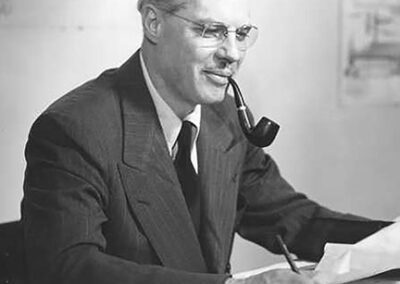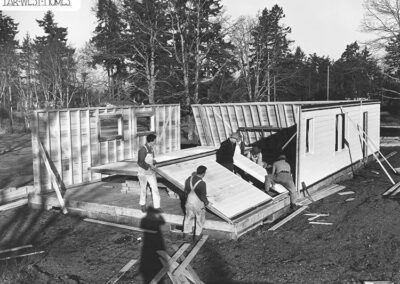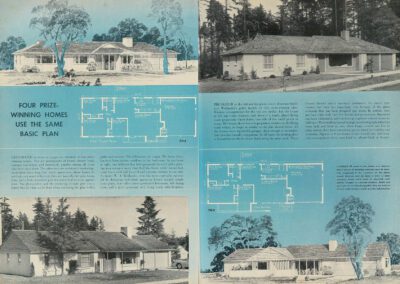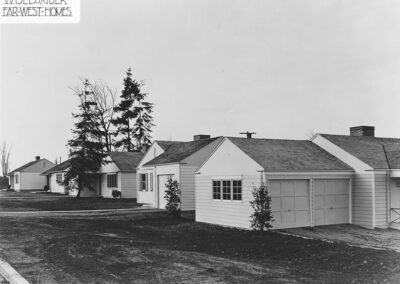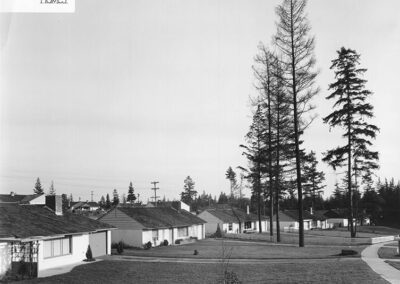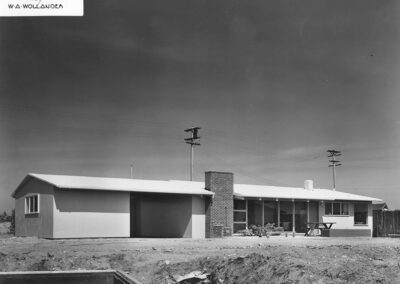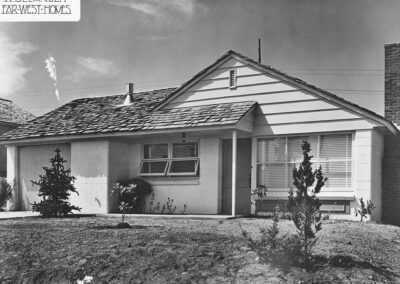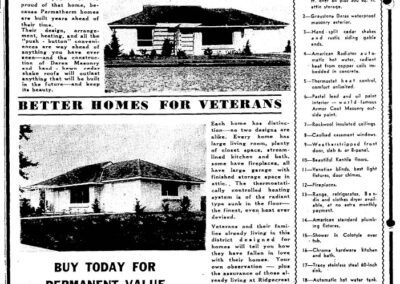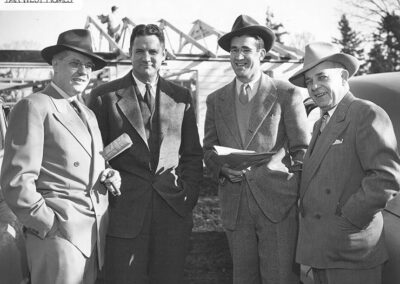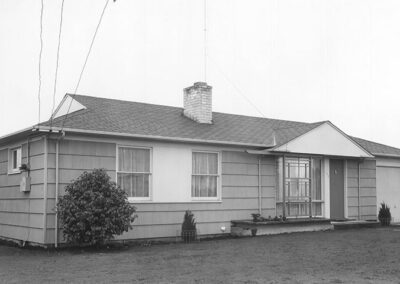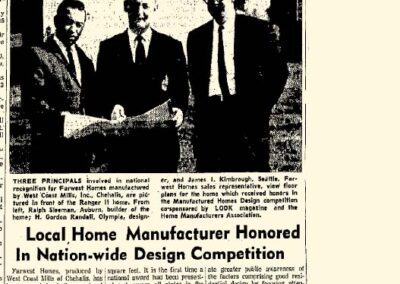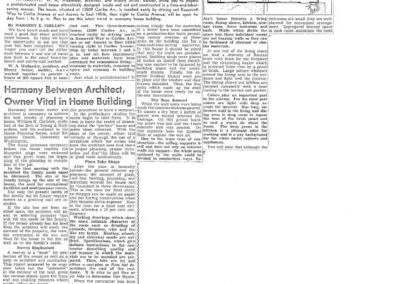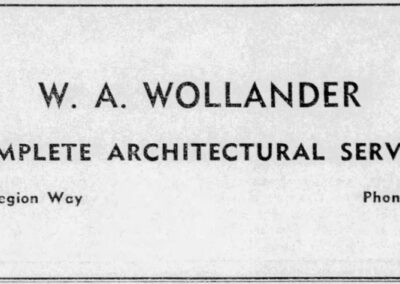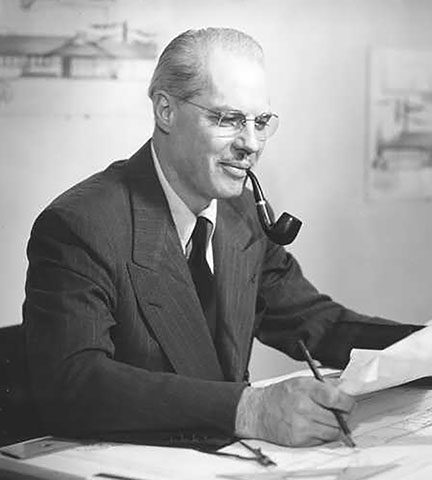
Wollander, Willard A.
(1906 – 1982)
Referred to as one of the nation’s foremost residential designers, Willard Adolph Wollander made a profound impact on home construction across the United States in the post war era. Reportedly over the course of his career his designs were used for the construction of more than 20,000 homes. A so-called “professional designer,” he never acquired an architectural license, and had no formal architectural training. Reportedly he was a professional musician and composer early in his career (1930-1935) and took classes at Dunwoody Institute, Augsburg College, and the Carnegie Institute of Technology. Per census records he also spent time as a painter & wall-paperer (1930), and artist at Bureau of Engraving (1938) in Minneapolis, Minnesota.
Wollander was born on November 15, 1906 in Cannon Falls, Minnesota, to large Swedish family. His dad, John, was a cabinet maker and his mom, Mathaida, took care of their eight children. At the age of 34, Wollander, his wife, Klare and their three children moved to Olympia. Why he came to the community is unknown, but his 1940 WWII draft card indicates he was self-employed.
That year he formed a retail lumber and building supply store with O.M. Kulien. Known as the Kulien-Wollander Company, per advertisements Wollander offered home design services. In 1942 they expanded the business into general contracting and went on to build numerous homes in Olympia and the surrounding communities. Wollander continued to supply home designs on the side to other builders such as Richard Kieburtz. Local papers identified his designs as “Wollander Type” homes.
Capitalizing on the demand for housing following World War II, Wollander decided to go into designing homes full time. He moved to Tacoma in 1948 and started to develop a strong business and marketing plan which would provide homeowners and builders with affordable plans for modest dwellings. His big break came in 1950 when his two-bedroom home plan, “The Olympia”, was featured in the April issues of the National Association of Home Builders monthly magazine, The Correlator.
Reportedly by 1953 he had designed over 5,000 homes scattered in over 50 cities across the United States. His plans, available via mail order, appeared in Architectural Forum, Good Housekeeping, Small Homes Guides, Pacific Northwest Book of Home, Western Homes magazine and numerous other publications. They were particularly appealable to builders due to the concept of using a simple house plan that could be rendered on the exterior in multiple ways.
An entrepreneur, Wollander decided to form his own construction company in the late 1940s. They were marketed under a variety of names such as Permatherm, Wollander Homes, and Wollander Better Builder Plans. In the 1940s he also decided to dabble in the world of prefabricated homes. Based at a factory in Chehalis, Wollander Farwest Homes were distributed up and down the west coast and as far east as the Mississippi, Michigan, Illinois, Ohio and Indiana. The company planned to build between 25 and 100 homes daily, using prefabricated building components. Consumers initially had a choice of 725, 832 or 920 square ft, two-bedroom houses, all available for under $6,000. His first full-scale model premiered at the first annual home show in Tacoma in 1949.
In the Seattle area, Wollander provided designs for many builders including Albert Balch (Wedgewood), Budget Homes Inc. (Mountlake Terrace), Evergreen State Builders (Twin Lakes, Fairwood), and Allied Homes Inc. (Tam O’Shanter). Six of his designs were featured in the 1950 Seattle Area Parade of Homes (all in Mountlake Terrace). The next year he designed two additional, more upscale homes, in Bellevue for the parade.
For reasons unknown, by the 1953 Wollander moved to Salem, Oregon. He continued to sell plans and complete prefab homes to homeowners, developers and builders until the late 1970s.
By the 1960s his design philosophy coalesced round the idea that homes should be built for people and not activities. Called “people zoned” he patented the moniker in 1965. The concept was designed to reverse the trend of open space living, and instead focused on the needs of the individual and subgroups by providing separate areas for adults and children, and a common space for the whole family.
Such strong ideas over design were pushed forth by Wollander via several self-published booklets including How Houses are Designed Professionally (1958), Ten Million Houses Can Be Wrong (1965), People-Zoned Plans (1967), and The Problem, A Solution (1969).
Still active into the 1970s, Professional Builder magazine, one of the largest shelter-industry publications, gave its top award to Wollander for his “House of Nine Gables” in 1975. He finally retired in 1980, taking up painting.
Wollander passed away in March 29, 1982 in Salem, Oregon at the age of 75.
– Michael C Houser
